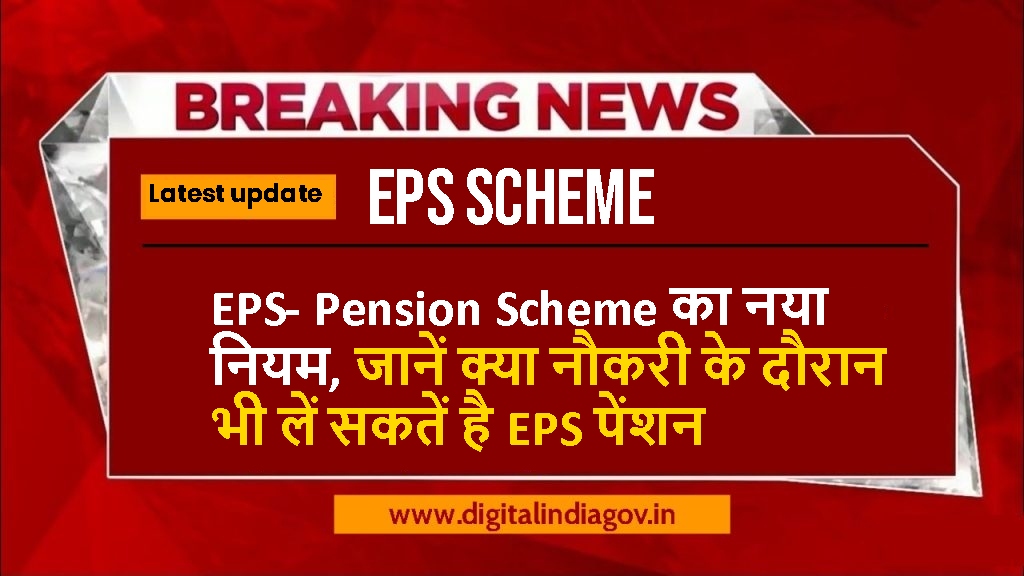EPS Scheme, The Employees’ Pension Scheme, or EPF Pension as it is officially known, was introduced in 1995 with the intention of assisting workers in the organised sector. Workers who qualify for the Employee Provident Fund (EPF) program will also qualify for EPS.
Contents
What is the Employees’ Pension Scheme
The Employees’ Pension Scheme is a social security program offered by the Employees’ Provident Fund Organisation (EPFO). Employees in the organised sector are eligible for a pension under the plan after they retire at age 58. However, only workers who have been with the company for ten years or more—though not necessarily continuously—are eligible for the advantages of the scheme. Both new and current members are eligible to participate in the EPF plan. The Employee Provident Fund (EPF) receives 12% of the income of both employers and employees. However, each month, the employee contributes their entire part to the Employee Provident Fund (EPF), the employer contributes 8.33% of their portion to the Employees’ Pension Scheme (EPS), and the employer contributes 3.67% of their portion to the EPF.
Also Read: SCSS Scheme Details, shaladarpanportalgov.com, yojanaforall.com, Onlinereferjobs
Eligibility Criteria
An individual must meet the following requirements in order to be eligible to receive benefits under the Employees’ Pension Scheme (EPS):
- He ought to be an EPFO member.
- He ought to have served for ten years.
- He is now 58 years old.
- Additionally, starting at age 50, he can withdraw his EPS at a discounted rate.
- Additionally, he can postpone his pension for two years (until he becomes 60), after which he will receive it at an extra rate of 4% annually.

How to Calculate Your Pension Under EPS
The member’s pensionable wage and pensionable service determine the amount of the pension in PF. The EPS formula, often known as the EPF pension calculation formula, is used to determine the member’s monthly pension amount:
a) Pensionable Salary
The average monthly pay for the final 60 months prior to a member leaving the Employees’ Pension Scheme is their pensionable salary. In the event that the last 60 months of employment contain non-contributory periods, the employee will receive the benefit of those days and the non-contributory days in the month will not be taken into account. Assuming that the individual starts work on the third of the month, his 28-day compensation will be split according to the pay for each day and then multiplied by 30 to determine the total monthly earnings for the month.
The person’s pay would be ₹14,000 for 28 days (₹500 per day less for two days) if their salary was ₹15,000. But for 30 days, the monthly pay taken into account for EPS would be ₹15,000. Every month, the maximum pensionable wage is ₹15,000. Given that the employer deposits 8.33% of this pay into the worker’s EPS account, the monthly amount transferred into the worker’s EPS account is ₹ 15000 x 8.33/100 = ₹ 1250
b) Pensionable Service
Pensionable service is defined as the member’s actual service duration. The pensionable service period is calculated by adding the service periods under various employers. Every time a person changes jobs, they must obtain and present the EPS Scheme Certificate to their new employer. It is important to note that after 20 years of service, the employee receives a two-year bonus. The member must begin contributing to the EPS account anew and the service period will be set to zero at the beginning if he withdraws the EPS corpus before the 10-year service time is up and he joins another company.
Six months are taken into account while calculating the pensionable service period. Six months is the bare minimum of pensionable service. The pensionable service time is eight years if the service period is eight years and two months. The pensionable service length is nine years, but, if the service duration is eight years and ten months.
Pension Benefits under the Employees’ Pension Scheme (EPS)
Pension benefits are available to all qualifying EPFO members based on their age as of the time they begin taking pension withdrawals. In certain situations, the pension amount varies.
1) Pension on Retirement at the Age of 58 Years
When a member retires at age 58, he is eligible to receive pension payments. However, in order to receive pension benefits, he must have served for a minimum of ten years by the time he becomes fifty-eight. Form 10D, which is needed to withdraw the monthly pension, can be filled out using the produced EPS Scheme Certificate.
2) Pension on Leaving Service before Becoming Eligible for Monthly Pension
A member may withdraw the full amount by completing Form 10C at the age of 58 if he is unable to serve for 10 years prior to reaching that age. It is important to note that once he retires, he will not receive his monthly pension benefits.
3) Pension on Total Disablement during the Service
Even if he hasn’t completed the pensionable service period, an EPFO member who becomes completely and permanently incapacitated is entitled to a monthly pension. To qualify for the pension, his employer must make deposits into his EPS account for a minimum of one month.
Beginning on the date of permanent disability, the member is eligible to receive the monthly pension, which is paid for the duration of his life. To determine whether he is unsuited for the work he was doing prior to becoming disabled, the member might need to have a medical checkup.
4) Pension for the Family on the Death of the Member
In the following situations, a member’s family is eligible to receive pension benefits:
- If the employer has contributed money to the member’s EPS account for a minimum of one month and the person passes away while still employed
- If the member passes away before turning 58 after completing ten years of service, or if the member passes away after the monthly pension has started

Also Read: AIF Scheme, Mobilenumbertrackeronline, indnewsupdates.com, ssorajasthanidlogin.com
Types of Pensions under Employees’ Pension Scheme
Under EPS, there are various kinds of pensions, including orphan, widow, and child pensions. The family member of the EPF subscriber receives income from these pensions.
1) Widow Pension
The widow of a member who is entitled to a pension may get a widow pension, also known as a Vridha pension. Until the widow passes away or remarries, the pension amount will be paid. If there are multiple widows, the eldest widow will receive the pension. According to Table-C of the EPS, 1995, the monthly Vridha pension amount is determined. As of right now, the minimum pension amount is ₹1000. The table below shows how the widow pension amount is determined based on the member pensioners’ pensionable wage of ₹6,500. Keep in mind that a greater pension can be attainable because the monthly pensionable wage has been raised to Rs 15,000:
| Monthly Pensionable Salary for Widow Pension ( ₹ ) | Monthly Widow Pension ( ₹ ) |
| 6200 | 2021 |
| 6250 | 2026 |
| 6300 | 2031 |
| 6350 | 2036 |
| 6400 | 2041 |
| 6450 | 2046 |
| 6500 | 2051 |
2) Child Pension
In addition to the monthly widow pension, the surviving children in the family are also eligible for a monthly children’s pension in the event of the member’s death. Until the child turns 25, the pension will be paid each month. A maximum of two children may receive the payment, which is equal to 25% of the widow’s pension.
3) Orphan Pension
If the member passes away without leaving a widow alive, his children will be eligible to receive a monthly orphan pension equal to 75% of the monthly widow pension. Two surviving children, ranked from oldest to youngest, will be eligible for the benefit.
4) Reduced Pension
After completing ten years of service and reaching the age of fifty but under fifty-eight, an EPFO member may take an early pension. In this instance, for each year the age is below 58, the pension amount is reduced by 4%. The member will get the pension at a rate of 92% (100% – 2 x 4) of the initial pension amount if he chooses to withdraw the monthly reduced pension at the age of 56.
How to Check Your EPS Amount
In his EPF Passbook, a member can view the total amount that has accrued in his Employees’ Pension Scheme (EPS) account. The EPS contribution that the employer deposits into the member’s account each month is displayed in the passbook’s final column. Once you have logged in with your UAN and password, you can download the passbook from the EPF Passbook page.
Important Points to Remember about EPF Pension
- The employer is responsible for making all contributions to the Employees’ Pension Scheme (EPS) account.
- 8.33% of the employee’s salary is contributed by the employer to EPS.
- Basic pay plus dearness allowance, retention allowance, and the acceptable cash value of meal concessions make up the employee’s compensation.
- Within 15 days following the end of each month, the employer must make the contribution.
- The employer is responsible for covering any applicable contribution costs.
- Contributions must be made by the major employer for each employee who works directly for him or through a contractor.
- To be eligible for pension benefits, one must have served for a minimum of ten years.
- If you have more than six months of service but less than ten years, you can withdraw the EPS amount after more than two months of unemployment.
- According to the plan, a person’s retirement age is set at 58 years old.
- After becoming 58 years old or beginning to receive a reduced pension (at age 50), an employee no longer qualifies as a member of the Pension Fund.

Also Read: Gold Investment Scheme, digitizeindiagovin.com, Typingspeedtestonline, Nebsit Council
Faq’s
Q. Where can I locate my account number for EPS?
Ans: The EPF account’s Member ID also serves as the EPS account. Your Member ID is used to deposit both your EPS and EPF contributions.
Q. How can I transfer EPS online?
Ans: The Composite Claim Form is an online tool for EPS transfers. After changing jobs, the member must apply for an EPF transfer by logging into the EPF Member Portal. The new account will instantly receive the EPF and EPS funds.
Q. What does an EPF passbook pension contribution mean?
Asn: The amount that the employer deposits each month into the employee’s EPS account is the pension contribution shown in the EPF passbook. Each month, it comes to about ₹1250.
Q. My mother has been receiving a widow pension each month since my father’s death. Do I also qualify for a pension of any sort?
Asn: In addition to the widow pension, the surviving children of a deceased member are also entitled to a children’s pension each month. Children’s pensions are paid at a rate of 25% of the widow’s pension each month to a maximum of two children.
@PAY
